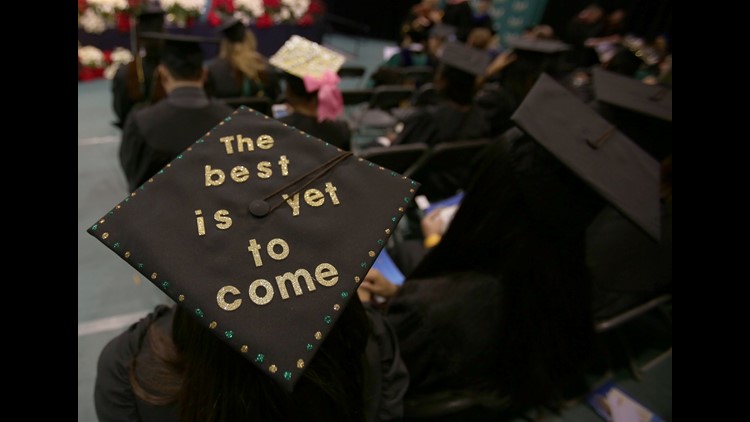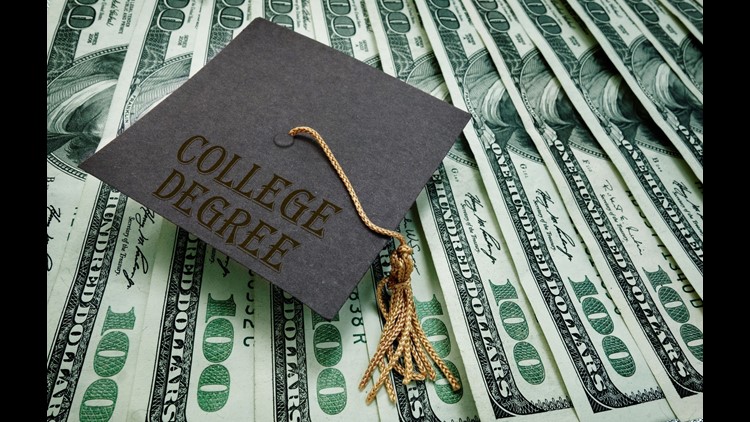
So, what do you do when you miss student loan payments and can’t keep up?
Some borrowers who fall behind have been encouraged to take action to temporarily suspend making payments on their student loans by setting up a general forbearance program to avoid going into default.
If they do that, the borrower can end up owing far more money in the long run on many federal loans.
“When borrowers are encouraged to put their student loans in forbearance, it often hurts them because they’re just delaying paying their loans,” said Abby Shafroth, staff attorney for the National Consumer Law Center. “They’re not doing anything to get ahead of their loans or keep up with them.”
Typically, a forbearance would work best for short-term troubles, such as unemployment, a temporary medical issue or maternity leave. If a borrower has a job that doesn’t pay well, it can be better to look into income-driven repayment plans.
Many federal student loans come with a six-month grace period after the student graduates or drops below half-time enrollment. If you graduate in May, repayment won’t begin until November. Many times, interest would keep building.
If you can’t pay, you want to figure out your options.
Troubling student loan statistics
A new study released by the U.S. Government Accountability Office raises some troubling concerns about how schools may be hiring third-party vendors who encourage troubled borrowers to take advantage of forbearance programs.
The GAO analysis found that:
- 68% of borrowers who were required to begin repaying college loans in 2013 had loans that ended up in forbearance during the first three years. But that group could include some short-term efforts, including an administrative forbearance for a month when a loan is consolidated or switches to a different repayment plan.
- More troubling, 20% of all borrowers had loans in forbearance for 18 months or more.
- Some schools have hired consultants who encourage borrowers with past-due payments to put their loans in forbearance.
- In some cases, forbearance programs have been recommended when a repayment plan based on monthly income would have been a better option. Some consultants even provided inaccurate or incomplete information regarding repayment options in some instances.
Mark Kantrowitz, publisher of www.PrivateStudentLoans.guru, said schools are focused on a key three-year measurement window relating to defaults.
According to federal law, schools may lose eligibility to participate in federal student aid programs if a sizable percentage of their borrowers default on student loans within the first three years of repayment. The three-year time frame is designed to hold schools accountable for high default rates.
If students put loans into forbearance, Kantrowitz said the potential for a default ends up being delayed and then pushed beyond that three-year window.
By delaying any defaults, the school can present a rosier picture that portrays its degrees as a valuable tool for getting a good paying job that would help the student pay off student loans quickly. In reality, though, many students could be stuck in low-paying jobs and may be unable to pay down their debts.
Holding down defaults during the three-year window also enables the school to attract students who can tap into federal financial aid programs when, maybe, it would be better if the school was cut off from such loans.
Many borrowers in long-term forbearance ended up defaulting anyway in the fourth year of repayment — when schools were no longer at risk of losing access to federal loans.
“From a borrower’s perspective, a forbearance is bad because interest continues to accrue and will be capitalized, digging the borrower into a deeper hole,” Kantrowitz said.
“It’s better than defaulting on the loan, but it is not a long-term solution.”
Forebearance is better than default
Make no mistake, you do not want to go into default. If you default on student loans, you will be subject to collection charges, wage garnishment and the government can seize your income tax refund. You will also put a dent in your credit score.
Default will be reported to credit bureaus, damaging your credit rating and affecting your ability to buy a car or house or to get a credit card.
But forbearance is a costly way to go — particularly if it drags out for a few years. And it won’t necessarily put borrowers on a path to ultimately repaying their loans.
A typical borrower with $30,000 in loans who spends the first three years of repayment in forbearance would pay an additional $6,742 in interest — or 17% more than the borrower would have paid otherwise, according to the new GAO study.
By applying for an income-driven repayment plan, a borrower can obtain a monthly payment amount that is intended to be affordable based on your income and family size.
Yet some borrowers who are behind on payments might opt for a forbearance because it seems simpler and more straightforward.
Easy to set up, hard to maintain
A general forbearance program is easy to set up over the phone and borrowers do not need to provide any documents that would back up why they cannot pay their loans now.
Shafroth, at the National Consumer Law Center, said in some cases the outside companies have included a forbearance application in their correspondence with college grads and others who are behind on payments.
The e-mails or letters might mention other options — such as income-driven repayment plans — but offer no information or forms on how to apply for such plans, which could be more helpful to the borrowers, she said.
To be sure, the forbearance form notes: “Instead of forbearance, you may want to consider requesting a deferment (which has an interest benefit for some loan types) or changing to a repayment plan that determines your monthly payment amount based on your income. Visit StudentAid.gov/IDR for more information.”
Borrowers will find applying for an income-driven plan far more complex — as you do need to show documentation. Shafroth also noted that default management companies also might be steering students toward forbearance because it is faster for the companies to help the student than the process involving income-driven repayment.

“The form to apply for income-driven repayment is 10 pages long and the federal government’s FAQ about income-driven repayment plans is 26 pages long,” Kantrowitz said.
“Income-driven repayment is inherently complicated and one has to recertify every year,” he said.
Even so, making regular payments, even reduced ones based on your income, will help in the long run.
Some students ultimately could qualify for forgiveness on their remaining loan balance after 20 years or 25 years of payments. And payments made each year through an income-driven plan would qualify, while the years spent in forbearance would not.
The hot topic at graduation parties, of course, typically isn’t how you plan to pay off your student loans. But it’s a strategy that is important to consider long before the first bill become due.
High school grads should take a look at some loan information that’s relevant to the college they want to attend. Look at the College Scorecard, run by the Department of Education. Go to CollegeScorecard.ed.gov. The site includes details about a school program’s average annual cost, graduation rate, salary after attending, typical total debt after graduation, typical monthly loan payment and the percentage of students paying down their debt.
College grads with student loans might consider the following tips to keep up payments:
- Sign up for auto-debit, where the monthly payments are automatically transferred from your bank account to the lender. Many lenders cut 0.25% off your rate as an incentive.
- Claim the student loan interest deduction on your federal income tax return, if possible. You may deduct the lesser of $2,500 or the amount of interest you actually paid during the year. The deduction is gradually reduced and eventually eliminated based on income limits.
- Use windfalls, such as income tax refunds, to make extra payments on your student loans. Kantrowitz recommends applying extra cash to the loan with the highest interest rate to save the most money. “Include a letter with instructions with the extra payment to specify (1) that it is an extra payment and not an early payment of the next installment and (2) that it should be applied to the loan with the highest interest rate (specify the loan ID number in the letter). Write the loan ID number on the check along with the words ‘extra payment,'” he said.
- Consider selling items you haven’t used in a while to pay down debt. Ask for cash for graduation gifts or birthday gifts to pay down your student loans.
Source:-myfoxzone






